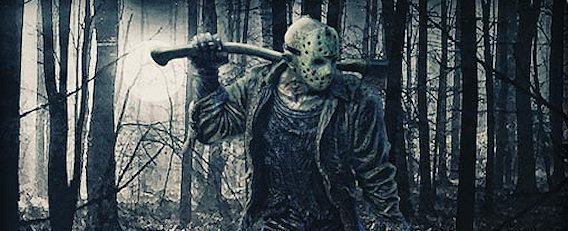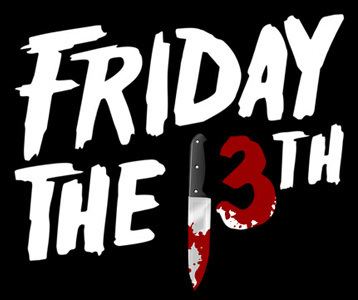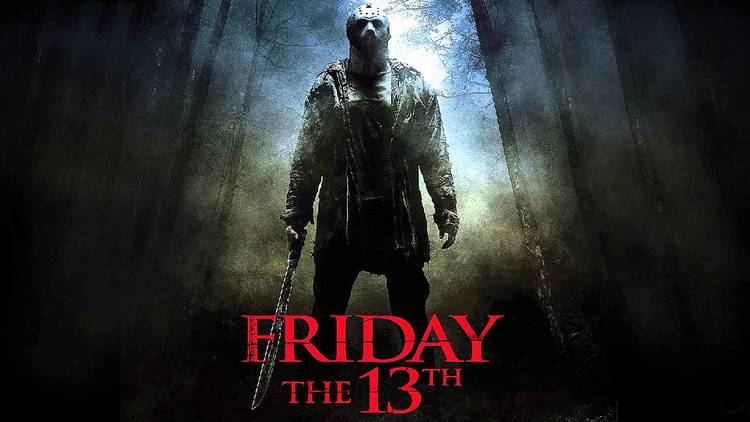Instances Friday the 13th (July, 2018) | ||
Friday the 13th the game killer pax east 2017 trailer
Friday the 13th is considered an unlucky day in Western superstition. It occurs when the 13th day of the month in the Gregorian calendar falls on a Friday. It occurs at least once every year, and up to three times a year. In 2017, it occurs twice, on January 13 and October 13. There will be two Friday the 13ths per year until 2020, where 2021 will have just one occurrence.
Contents
- Friday the 13th the game killer pax east 2017 trailer
- Friday the 13th top 13 kills
- History
- Tuesday the 13th in Hispanic and Greek culture
- Friday the 17th in Italy
- Social impact
- Rate of accidents
- Occurrence
- Frequency in a year
- References
Friday the 13th top 13 kills
History

The fear of the number 13 has been given a scientific name: "triskaidekaphobia"; and on analogy to this the fear of Friday the 13th is called paraskevidekatriaphobia, from the Greek words Paraskeví (Παρασκευή, meaning "Friday"), and dekatreís (δεκατρείς, meaning "thirteen").

The superstition surrounding this day may have arisen in the Middle Ages, "originating from the story of Jesus' last supper and crucifixion" in which there were 13 individuals present in the Upper Room on the 13th of Nisan Maundy Thursday, the night before his death on Good Friday. While there is evidence of both Friday and the number 13 being considered unlucky, there is no record of the two items being referred to as especially unlucky in conjunction before the 19th century.

An early documented reference in English occurs in Henry Sutherland Edwards' 1869 biography of Gioachino Rossini, who died on a Friday 13th:
He [Rossini] was surrounded to the last by admiring friends; and if it be true that, like so many Italians, he regarded Fridays as an unlucky day and thirteen as an unlucky number, it is remarkable that on Friday 13th of November he passed away.
It is possible that the publication in 1907 of Thomas W. Lawson's popular novel Friday, the Thirteenth, contributed to disseminating the superstition. In the novel, an unscrupulous broker takes advantage of the superstition to create a Wall Street panic on a Friday the 13th.
A suggested origin of the superstition—Friday, 13 October 1307, the date Philip IV of France arrested hundreds of the Knights Templar—may not have been formulated until the 20th century. It is mentioned in the 1955 Maurice Druon historical novel The Iron King (Le Roi de fer), John J. Robinson's 1989 work Born in Blood: The Lost Secrets of Freemasonry, Dan Brown's 2003 novel The Da Vinci Code and Steve Berry's The Templar Legacy (2006).
Tuesday the 13th in Hispanic and Greek culture
In Spanish-speaking countries, instead of Friday, Tuesday the 13th (martes trece) is considered a day of bad luck.
The Greeks also consider Tuesday (and especially the 13th) an unlucky day. Tuesday is considered dominated by the influence of Ares, the god of war (Mars in Roman mythology). The fall of Constantinople to the Fourth Crusade occurred on Tuesday, April 13, 1204, and the Fall of Constantinople to the Ottomans happened on Tuesday, 29 May 1453, events that strengthen the superstition about Tuesday. In addition, in Greek the name of the day is Triti (Τρίτη) meaning the third (day of the week), adding weight to the superstition, since bad luck is said to "come in threes".
Tuesday the 13th occurs on a month starting on Thursday.
Friday the 17th in Italy
In Italian popular culture, Friday the 17th (and not the 13th) is considered a day of bad luck. The origin of this belief could be traced in the writing of number 17, in Roman numerals: XVII. By shuffling the digits of the number one can easily get the word VIXI ("I have lived", implying death in the present), an omen of bad luck. In fact, in Italy, 13 is generally considered a lucky number. However, due to Americanization, young people consider Friday the 13th unlucky as well.
The 2000 parody film Shriek If You Know What I Did Last Friday the Thirteenth was released in Italy with the title Shriek – Hai impegni per venerdì 17? ("Shriek – Do You Have Something to Do on Friday the 17th?").
Friday the 17th occurs on a month starting on Wednesday.
Social impact
According to the Stress Management Center and Phobia Institute in Asheville, North Carolina, an estimated 17 to 21 million people in the United States are affected by a fear of this day, making it the most feared day and date in history. Some people are so paralyzed by fear that they avoid their normal routines in doing business, taking flights or even getting out of bed. "It's been estimated that [US]$800 or $900 million is lost in business on this day". Despite this, representatives for both Delta Air Lines and now-defunct Continental Airlines have stated that their airlines do not suffer from any noticeable drop in travel on those Fridays.
In Finland, a consortium of governmental and nongovernmental organizations led by the Ministry of Social Affairs and Health promotes the National Accident Day, which always falls on a Friday the 13th.
Rate of accidents
A study in the British Medical Journal, published in 1993, concluded that there "is a significant level of traffic-related incidences on Friday the 13th as opposed to a random day, such as Friday the 6th, in the UK." However, the Dutch Centre for Insurance Statistics on 12 June 2008 stated that "fewer accidents and reports of fire and theft occur when the 13th of the month falls on a Friday than on other Fridays, because people are preventatively more careful or just stay home. Statistically speaking, driving is slightly safer on Friday the 13th, at least in the Netherlands; in the last two years, Dutch insurers received reports of an average 7,800 traffic accidents each Friday; but the average figure when the 13th fell on a Friday was just 7,500."
Occurrence
In years which begin on the same day of the week and are of the same type (that is, whether they are a common year or leap year), Friday the 13th occurs in the same months.
The following months for each year from 1900 to 2100 have a Friday the 13th:
This sequence, given here for 1900–2099, follows a 28-year cycle from 1 March 1900 to 28 February 2100. The months with a Friday the 13th are determined by the Dominical letter (G, F, GF, etc.) of the year. Any month that starts on a Sunday contains a Friday the 13th, and there is at least one Friday the 13th in every calendar year. There can be as many as three Friday the 13ths in a single calendar year; either in February, March and November in a common year starting on Thursday (such as 2009, 2015 or 2026) (D), or January, April and July in a leap year starting on Sunday (such as 2012) (AG).
The longest period that can occur without a Friday the 13th is fourteen months, either from July to September the following year being a common year starting on Tuesday (e.g., between 2001–02, 2012–13, and 2018–19), or from August to October the following year being a leap year starting on Saturday (e.g., between 1999–2000 or 2027–28).
The shortest period that can occur with a Friday the 13th is just one month, from February to March in a common year starting on Thursday.
Each Gregorian 400-year cycle contains 146,097 days (365 × 400 = 146,000 normal days, plus 97 leap days). 146,097 days ÷ 7 days per week = 20,871 weeks. Thus, each cycle contains the same pattern of days of the week (and thus the same pattern of Fridays that are on the 13th). The 13th day of the month is slightly more likely to be a Friday than any other day of the week. On average, there is a Friday the 13th once every 212.35 days (compared to Thursday the 13th, which occurs only once every 213.59 days).
The distribution of the 13th day over the 4,800 months is as follows:
Frequency in a year
In the 2010s there were three Friday the 13ths in 2012 and 2015, and two in 2013. There will also be two 2017, 2018, 2019, and 2020. In the 2020s, there will be three F13's in 2026, and two in 2020, 2023, 2024, 2029, and 2030. The rest of years have at least one F13 if they don't have two or three in the 2010s and 2020s. Assuming nothing is changed with the calendar there is never more than three F13s in year. There is a 28 year cycle that repeats when there is a F13 in February, March and November, and the current start of that pattern was in 2009. Although there is at least one F13 per calendar year, it can be as long as 14 months between two F13s.
In Finland one F13 is chosen as National Accident Day to raise awareness about automotive safety, this is possible because there is at least one F13 each year.
